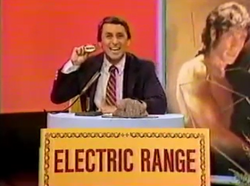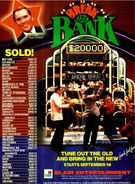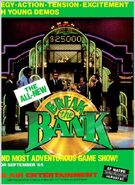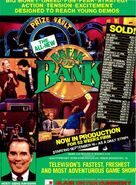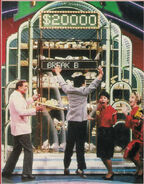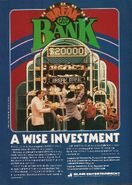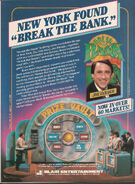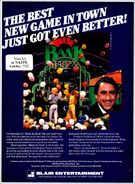| Hosts | |
| Gene Rayburn (1984–1985) Joe Farago (1985–1986) | |
| Hostesses | |
| Kandace Kuehl (first three shows) Julie Hayek | |
| Announcer | |
| Michael Hanks | |
| Broadcast | |
| Pilot: 9/17/1984 Syndication (Daily): 9/16/1985 – 6/20/1986 (reruns aired until 9/12/1986) | |
| Packagers | |
| Kline & Friends Storer Communications Hubbard Broadcasting, Inc. | |
| Distributor | |
| Blair Entertainment | |
This was the third game show to use the title of Break the Bank. In this version, two couples tried to build-up the most time by answering questions and solving puzzles.
Gameplay[]
Two couples competed to answer questions and solve puzzles for the right to break the bank.
There were two formats to this series.
Format #1[]
In this format, couples competed for time to use in the bonus game. Two couples tried to build up time by solving puzzles.
Main Game[]
In the main game, the couples were asked up to six questions. On each question, when a couple knew the answer, they had to press their buzzer. A correct answer earned the amount of time offered for that question, but an incorrect answer gave the opposing couple a chance to answer.
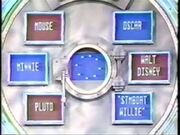
What solution goes with these six clues?
Each answer was a clue to a puzzle. A correct answer also gave the couple a chance to either solve the puzzle, or answer another question for more time. Solving the puzzle won the round, but an incorrect solve gave the opposing couple the right to answer the next question unopposed. If the puzzle wasn't solved after all six clues, one last question was played in which the answer to it was the puzzle's solution. Answering that question correctly won the round.
Pilot[]
In the pilot, the time values were different and for each round too.
| Round 1 | Round 2 | Round 3 | |
|---|---|---|---|
| Question #1 | 2 | 4 | 8 |
| Question #2 | 4 | 8 | 16 |
| Question #3 | 8 | 16 | 32 |
| Question #4 | 16 | 32 | 64 |
| Question #5 | 32 | 64 | 128 |
| Question #6 | 64 | 128 | 256 |
Notice that all times double for each new question; plus the time values were not cumulative, they were augmentations.
In the first round, the women play alone and against each other. The second round saw the men do the same thing. The third and final round allowed all four contestants to play.
Solving each puzzle was worth $500 in cash.
The team with the highest amount of time after the three rounds of gameplay, wins the game.
Series[]
In the series, the time values went like this:
- Question #1 – 5 seconds
- Question #2 – 10 seconds
- Question #3 – 20 seconds
- Question #4 – 40 seconds
- Question #5 – 80 seconds
- Question #6 – 100 seconds
The first couple to solve two puzzles won the game. If there was a tie at one puzzle apiece, one last puzzle was played but without questions. The clues were revealed one at a time, and the first team to buzz-in and solve the puzzle, won the game plus a bonus of 30 seconds. Answering incorrectly revealed all the other clues together for the other couple, and they then got to guess.
Assuming a couple answered all six clues and solved the puzzle both times, the maximum possible time would be 510 seconds (8:30). If they missed one of the first two puzzles but solved the tiebreaker, it was 540 seconds (9:00). In the case of a tie where both couples each answered all six clues and then solved the puzzle in the first two rounds, the max would only be 285 seconds (4:45), counting the tiebreaker.
Prize Vault[]
The winning couple then took their seconds to the bonus round area called the Prize Vault. To start, the winning time was entered as a combination into an electronic lock by the winning team in pilot and in the series by the hostess. This would cause the handle in the center of the Prize Vault door to rotate, before the door opened to reveal the full Vault. The Prize Vault was loaded with nine skill/knowledge based events/games, with fifty bank cards distributed among them. One card, if chosen, would "Break the Bank." The bank in question was a growing jackpot of cash and prizes which started at $20,000 ($5,000 of it was in cash), and grew each day by $500 in cash and a prize (later two prizes) until won. The jackpot also included a new car (initially a Mazda GLC, later a Mazda 323, but sometimes a Suzuki Samurai was offered). In the pilot, however, it was a flat $25,000. The winning team used their earned time to play as many of those games as possible.
Each event was worth a prize and a bank card, successfully completing an event won the prize, and selected one of 5-10 bank cards. The players would start from behind a podium situated on the right side of the Prize Vault, modeled after a teller's cage; to successfully earn the prize and the bank card, they had to take the card back to the podium and insert it into a slot (a display on the podium's front kept track of how much in prizes they earned throughout the round). (Failure to do so when time ran out would mean that prize and bank card were lost, even if they were on their way to doing so if time ran out.) For most of the first format, the players on the winning team took turns playing each event; near the end of this format, both players played all the events.
Among the Prize Vault stunts/events featured were:
- Answering true or false questions from a celebrity look-alike
- Trying not to laugh for a certain amount of time with a comic routine given by a celebrity comedian
- Identifying smells or noises while blindfolded
- Identifying songs played on musical instruments
- Reciting a faux photo news roundup
- Reciting a long tongue-twister
- Playing a game of tic-tac-toe with a person in a gorilla suit
- Identifying charades from a mime
- Finishing lines to popular songs, comic punchlines or TV and movie quotes
In the pilot, one event (played for a trip) would immediately cost the winning couple a full minute.
During this bonus in the series, one of the randomly selected events could be played for extra bank cards. Choosing that event had one member of the winning team (the controlling member for most of the first format) run to the "Number Jumbler" which jumbled numbers 0-5. That player then pressed a button to stop the Number Jumbler, and to determine how many bank cards they received for free.
Initially, the clock ran throughout the round, but after a few weeks and to save the couple some time, the clock froze while the host explained the stunt. As time began to wind down, announcer Hanks informed everybody how much time was left. Play continued until time ran out. Also, for the first few shows, the timer, always displayed in a white vane font, was inside a blue rectangle, later changed to a black-pink gradient rectangle, and finally, to not being in a shape at all. (When the third clock was introduced, that's when they began to "freeze" any remaining time while the host explained how the stunt worked.)
The winning couple then took their earned bank cards to a giant neon bank vault (with the show's logo on top), for a chance to "Break the Bank". One at a time, the couple stuck each one into a slot, which revealed a numerical code in a digital readout. If that code was the one that caused the card to "Break the Bank", everything in the bank was theirs. Along the way, even when the couple started to run out of bank cards, they had an option to trade them in for a cash and/or prize bailout, or continue trying to break the bank. If a team failed to break the bank, the next time they made it to the vault the bank cards that were selected the previous day were taken out of play.
Format #2[]
Shortly after Farago took over as the new host, the format was altered.
Main Game[]
The main game was played the same, except the couples now played for money instead of time.
Correct answers in Round 1 were worth $100, and correct answers in the Round 2 were worth $200. In addition, couples who solved the puzzle in the first two rounds won a prize. Round three was played just like the tiebreaker in the first format: a series of puzzles were played without questions. Each puzzle solved was worth $400, and the first couple to reach $2,000 or more won the game. Only the winners got the keep the cash.
Bonus Game[]
In the new bonus game, the winning couple was given one bank card to start, and tried to solve one more puzzle which was dubbed the "Master Puzzle" for up to nine more for a total of ten. Each clue had an assigned number of bank cards (1, 2, or 3), which told how many it would cost the couple just by seeing the clue. They were shuffled via a randomizer, and stopped when the winning couple hit a buzzer in front of them. Solving the puzzle won the remaining bank cards. Then it was time to go into the Prize Vault to win cash and prizes and potentially "Break the Bank".
Forty bank cards were displayed on a stand. Thirty-eight contained cash or prizes, one was the card that will "Break the Bank", and another was a "Bankrupt Card". The couple selected the number of Bank Cards earned one-by-one, and whatever cash amounts and/or prizes came up, those prizes and the cash was theirs unless they picked the "Bankrupt Card", so-named because choosing that card lost all the cash and prizes earned up to that point and ended the bonus round. To prevent this from happening, the couple had the option to stop and take the cash and prizes or play on. And if the couple chose the "Break the Bank" card, they retired undefeated. Every day the championship couple returned to the vault, bank cards that were selected the previous day (minus the Bankrupt card), were taken out of play.
Champions' Limit[]
Originally, champions stayed until winning more than $75,000, with any money exceeding it going to charity. Later, couples retired from the show if they broke the Bank, again donating any winnings over $75,000 to charity. This was because the series aired on WCBS in New York, and any syndicated game show that aired on that station had to adhere to CBS's game show winnings limit.
Music[]
Pilot Opening Theme - "Courtship" by Bob James
Series - Hal Hidey
Studio[]
Rating[]
International Versions[]
On Chile's Sabado Gigante, one of the games played was based on Break the Bank ('85), but that version used three solo contestants rather than married couples. The bonus game used Farago's "Master Puzzle" format, and was played for a house rather than a prize packager, by inserting keys in a slot instead of cards.
Despite its failure in America, the 1980s Break the Bank found its way to France as La Porte Magique (The Magic Gate) from September 14, 1987 to November 12, 1988 on the now defunct French channel called La Cinq (The Five). The series was hosted by Michel Robbe and used a set similar to that of the American series with the original bonus round format for at least part of the run. The number of seconds earned per correct answer also used the 5-10-20-40-80-100 layout.[1]
Trivia[]
At the time, Gene Rayburn was promoted to host a revival of his signature hit game show Match Game not only once, but twice. First in 1985 in order to be paired up with the nighttime syndicated revival of The Price is Right hosted by Tom Kennedy, and then again in late 1986, after he was fired from this show 13 weeks earlier.
Before he replaced Rayburn, Farago was originally one of the actors in the bonus game appearing from the September 16 and the September 18, 1985 episodes respectively of the Rayburn era.
When Farago took over as host he would read off the clues not used in the puzzle just solved. Rayburn never did that.
For a brief period, the show used the Family Feud Face-Off buzzer sounds for the main game buzzers and later also for a brief period, it was used as the shuffle stopping sound. (In most episodes, a "warble", previously used as a "time's up" sound on Barry and Enright shows, was used.) In addition, other sound effects previously used on Barry and Enright shows were also used, including Tic Tac Dough's (1978) shuffle sound and also for a brief period, two sound effects from Hot Potato.
The largest bank ever won was $53,323, by Gene and Sandy (last names unknown), from the Farago run. As their grand total surpassed the $75,000 threshold, they donated overage of $13,354 to charity.
Stations[]
Stations that carried the show included:
- New York - WCBS-TV
- Los Angeles - KHJ-TV
- Chicago - WLS-TV
- San Francisco - KTVU
- Sacramento - KOVR
- Des Moines - WHO
- Minneapolis - KSTP-TV
- Cleveland - WJW
- Baltimore - WBAL-TV
- Atlanta - WAGA-TV
- Boston - WSBK-TV
- Seattle - KCPQ
- Detroit - WJBK
- Houston - KHTV
- Dallas - KXTX-TV
- Miami - WSVN
- Las Vegas - KTNV-TV
- Hartford - WVIT
- Greenville, SC - WLOS
- Pittsburgh - WPXI
- Milwaukee - WITI
- Louisville - WLKY
- St. Louis - KTVI
- Indianapolis - WRTV
- San Diego - KNSD
- Albuquerque - KOB
- Tampa - WTOG
- Nashville - WTVF
- Charlotte - WCNC
- Dayton - WDTN
- Albany - WRGB
- Providence - WPRI
- Jacksonville - WJKS
- West Palm Beach - WPEC
- Rochester - WOKR
- Chattanooga - WTVC
- Tuscon - KVOA
- Springfield, MA - WWLP
- Greenville, NC - WCTI-TV
- Fargo - KVRR
- Reno - KOLO
- Lubbock - KLBK-TV
- Medford - KOBI
- Utica - WUTR
- Salem, OR - KECH
- Yuma, AZ - KECY
- Casper - KXWY
- Cheyenne - KLWY
- Columbus, OH - WSYX
Trade Ads[]
Additional Page[]
Break the Bank (3)/Catchphrases
Links[]
Break the Bank '85 at Game Show Utopia
Rules for Break the Bank '85
Another Break the Bank '85 Rules Page
YouTube Videos[]
Clip of the 1st Version Bonus Round
Clip of the 2nd Version Bonus Round


